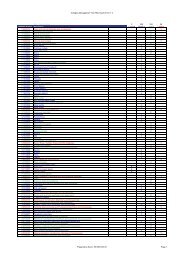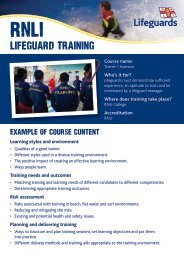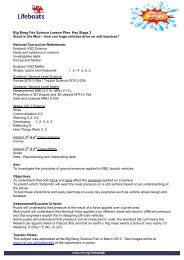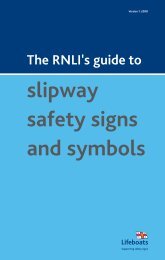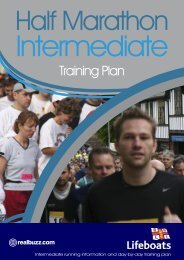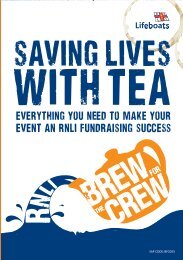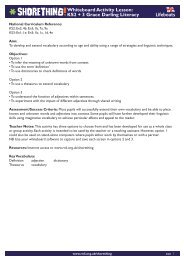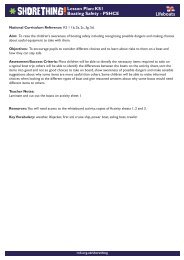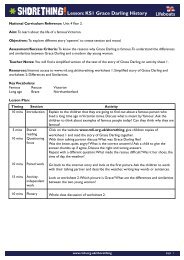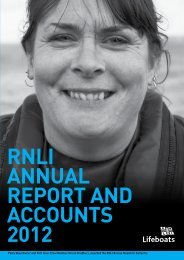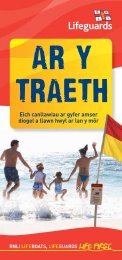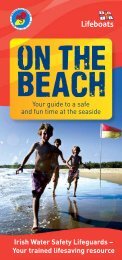RNLI ANNUAL OPERATIONAL STATISTICS REPORT 2011
RNLI ANNUAL OPERATIONAL STATISTICS REPORT 2011
RNLI ANNUAL OPERATIONAL STATISTICS REPORT 2011
- No tags were found...
Create successful ePaper yourself
Turn your PDF publications into a flip-book with our unique Google optimized e-Paper software.
<strong>RNLI</strong> <strong>ANNUAL</strong> <strong>OPERATIONAL</strong><strong>STATISTICS</strong> <strong>REPORT</strong> <strong>2011</strong>
ContentsPagePhoto: <strong>RNLI</strong>/Nigel MillardForeword 1Concept of Operations 2Strategic performance standards 2Definitions 3Lifeboat statistics overview 5Lifeboat statistics 2007–11 6Lifeboat statistics <strong>2011</strong> 8Lifeguard statistics overview 15Lifeguard statistics <strong>2011</strong> 16Coastal Safety statistics <strong>2011</strong> 22Youth Engagement statistics <strong>2011</strong> 26Rescue map 2832
ForewordWelcome to the <strong>RNLI</strong> Annual Operational Statistics Report <strong>2011</strong>. The report is intended for bothinternal and external communication and paints the picture of lifesaving, coastal safety and youthengagement activity carried out in delivering the <strong>RNLI</strong>’s core purpose of saving lives at sea.During the course of <strong>2011</strong>, lifeboats and hovercraft launched on 8,905 occasions (2010: 8,713),rescuing 7,976 people (2010: 8,313) including 354 lives saved (2010: 309). The Thames lifeboats,which are included in these figures, launched on 919 occasions (2010: 894), rescuing 245 people(2010: 297) including 28 lives saved (2010: 29).The trend for <strong>2011</strong> shows a reduced peak of activity in August, probably due to the relativelypoor weather at that time, but has also been characterised by surges in activity in April, May andSeptember that are coincident with periods of good weather around these times. Overall, <strong>2011</strong> hasseen the second highest number of lifeboat launches in the <strong>RNLI</strong>’s history and the highest numberof lives saved in the last 5 years.<strong>RNLI</strong> lifeguards were present on 163 beaches in <strong>2011</strong> and saved 84 lives (2010: 107). Theyattended 15,625 incidents (2010: 16,664) and aided a total of 17,671 people (2010: 18,779).These figures are lower than the previous year and are probably influenced by a combination ofimproving preventative interventions by lifeguards and the inclement weather experienced overthe course of the Summer.Underpinning this activity, our Coastal Safety and Youth Engagement Teams continued to deliverkey safety messages, demonstrations and advice across a wide spectrum of audiences.All this was conducted against the backdrop of the <strong>RNLI</strong>’s Lean initiative, which has beenestablished to improve efficiencies and realise savings in order that we can invest more in our corepurpose of saving lives.As ever, none of this could be achieved without the support and engagement of our volunteers,supporters and staff, without whom we could not deliver such an effective lifesaving service.Thank you all – it is your dedication and support that make a real difference to people’s lives.Michael VlastoOperations Director1
Concept of OperationsStrategic performance standardsThe <strong>RNLI</strong> saves lives at sea throughout the UK and RoI by providing:• a strategically located fleet of all-weather lifeboats, which are available at all times,and tactically placed inshore craft, which are subject to weather limitations• a lifeguard service on a seasonal basis• safety education and accident preventionto a defined standard of performance, commensurate with the resources available, using trainedand competent people who, wherever possible, are volunteers.We aim to:• achieve an average launch time of 10 minutes from notification to the <strong>RNLI</strong>- an overall average launch time of 10.3 minutes was achieved in <strong>2011</strong> (2010: 10 minutes).There was an increase in call outs to incidents during the core working day in the year,with crew having to travel from work rather than home, which may have resulted in thisslight increase in launch times• reach all notified casualties where a risk to life exists, in all weathers, out to a maximumof 100 nautical miles- in <strong>2011</strong>, lifeboats launched on service 8,905 times (2010: 8,713), rescuing 7,976 people(2010: 8,313), and saving 354 lives (2010: 309)• reach at least 90% of all casualties within 10 nautical miles of the coast within30 minutes of launch in all weathers- the performance standard achieved in <strong>2011</strong> was 92.9% (2010: 92.5%). The improvementon the 2010 figure probably resulted from the periods of relatively good weather in theSpring and Autumn of <strong>2011</strong>• reach any beach casualty up to 300m from shore, within the flags, on <strong>RNLI</strong> lifeguardpatrolledbeaches, within 3½ minutes- in <strong>2011</strong>, <strong>RNLI</strong> lifeguards attended 15,625 incidents on <strong>RNLI</strong>-patrolled beaches (2010:16,664), aided 17,671 people (2010: 18,779) and saved 84 lives (2010: 107). It is not costeffective to measure the average response time but our risk assessment process,fitness standards and operational configuration of the lifeguard service are all designedto achieve this strategic performance standard• deliver clear, straightforward safety advice that positively influences behaviour,measured against agreed benchmarks- in <strong>2011</strong>, key marine safety messages and advice around lifejackets and safety equipmentwere delivered through roadshows, presentations and face-to-face communications,reaching a total audience of well over 48,000 people. Beach safety advice has also beendelivered through the key face-to-face programmes of Beach to City, Meet the Lifeguardsand Hit the Surf and reached a combined audience of over 90,000. Key safety messageswere also disseminated through a multi-channel approach, including outdoor media, theinternet, and radio and magazine adverts – with estimated potential audiences of up to20M people.2
DefinitionsLifeboatsLives saved – where, if not for the actions of the lifeboat and/or its crew, a life would havebeen lost.Person landed – where a lifeboat rescues a person who is at risk but not in a life-threateningsituation.Person brought in – where a lifeboat rescues a person who is at very little risk, if at all, but if leftwould probably have been at risk later.People rescued – a combination of the above three categories.LifeguardsLives saved – where, if a lifeguard had not intervened, life would have been lost.Rescue – where a lifeguard responds to a person at risk and physically returns them to shore ortransfers them to another rescue craft.Assistance – when a lifeguard aids a person in the sea who is at very little risk but would be at risklater if left.Major first aid – more serious injuries or illnesses where a lifeguard formally assesses and/ortreats a casualty according to the <strong>RNLI</strong> casualty care protocols.Minor first aid – where a lifeguard treats a casualty due to sickness or injury who is at low or norisk but requires treatment to ensure a risk does not develop.Missing/found person – where a lifeguard assists in the location of children, separated from theirparents/guardians, or other persons who have been found or reported missing.Near miss – when a lifeguard observes an incident, event or condition that does not cause deathor serious injury but has the potential to do so.Search – an organised search, with other search and rescue units, for a missing person either atsea or on land; includes body recovery.People aided – a combination of the above eight categories.Preventative action – a high percentage of lifeguard activity is classed as preventative. This isrecorded on daily log forms to give an indication of how often the lifeguards prevent situationsdeveloping on the beach.3
4Photo: <strong>RNLI</strong>/Nigel Millard
Lifeboat statistics overview<strong>2011</strong>LifeboatsNumber<strong>2011</strong> was the <strong>RNLI</strong>’s second busiest year in its history.2009 was the busiest with 9,223 launches.Launches 8,905Lives saved 354People landed 1,846People brought in 5,776People rescued (saved, landed and brought in combined) 7,9762007–11Year2007Rescue craft Launches Lives saved People rescued(including lives saved)ALB 2,578 81 3,296ILB 5,518 223 4,492IRH 79 1 582007 Total 8,175 305 7,8462008ALB 2,539 103 3,319ILB 5,694 184 4,269IRH 60 1 242008 Total 8,293 288 7,6122009ALB 2,602 87 3,197ILB 6,528 242 4,979IRH 76 4 59RWC 17 0 02009 Total 9,223 333 8,2352010ALB 2,457 71 3,457ILB 6,155 235 4,810IRH 75 3 44RWC 26 0 22010 Total 8,713 309 8,313<strong>2011</strong>ALB – all-weather lifeboatILB – inshore lifeboatIRH – inshore rescue hovercraftRWC – rescue watercraftALB 2,521 82 3,152ILB 6,305 270 4,785IRH 59 2 39RWC 20 0 0<strong>2011</strong> Total 8,905 354 7,9765
Lifeboat statistics 2007–11Lifeboat launches and number of people rescued (including lives saved)LaunchesPeople rescued9,4009,2009,223Year Lives saved2007 3052008 288Number of launches and people rescued9,0008,8008,6008,4008,2008,0008,1757,8468,2938,2358,7138,3138,9057,9762009 3337,8002010 309<strong>2011</strong> 3547,6007,61202007 2008 2009 2010 <strong>2011</strong>YearLifeboat launches by divisionDivisionYear/Number of launches2007 2008 2009 2010 <strong>2011</strong>East 2,348 2,707 2,933 2,834 2,906Ireland 951 876 990 1,002 980North 1,147 1,035 1,288 1,090 1,270Scotland 1,032 973 1,122 1,012 1,006South 1,546 1,574 1,671 1,552 1,585West 1,136 1,114 1,206 1,207 1,147No division(on-passage services)15 14 13 16 11Total 8,175 8,293 9,223 8,713 8,9056
Lifeboat statistics 2007–11People rescued by divisionDivisionYear/Number of people rescued2007 2008 2009 2010 <strong>2011</strong>East 2,191 2,203 2,392 2,588 2,341Ireland 1,144 1,010 1,026 1,094 905North 1,135 831 964 1,013 1,237Scotland 886 768 912 921 847South 1,465 1,675 1,704 1,559 1,571West 1,018 1,122 1,227 1,121 1,067No division(on-passage services)7 3 10 17 8Total 7,846 7,612 8,235 8,313 7,976Lifeboat launches by month20071,800200820092010<strong>2011</strong>Number of launches1,6001,4001,2001,0008006004002000Jan Feb Mar Apr May Jun Jul Aug Sept Oct Nov DecMonthThe peaks reflect good weather and increased leisure activity around the coast and at sea.7
Lifeboat statistics <strong>2011</strong>By divisionDivisionNumber oflifeboatstationsNumber oflifeboatsLaunchesLives savedTotal people rescued(including lives saved)East 43 70 2,906 90 2,341Ireland 43 57 980 49 905North 33 54 1,270 38 1,237Scotland 45 53 1,006 37 847South 35 55 1,585 59 1,571West 36 53 1,147 81 1,067No division(on-passage services)n/a n/a 11 0 8Total 235 342 8,905 354 7,976*South Broads Lifeboat Station closed in November <strong>2011</strong>.Statistics include services conducted by this station up to November.Number of lifeboat launches in varying wind speeds2,2002,0002,0441,8001,7941,6001,6091,400Number of launches1,2001,0008001,24398760057140033020002078128 6 4 112 – Hurricane (64+)11 – Violent storm (56–63)10 – Storm (48–55)9 – Severe gale (41–47)8 – Gale (34–40)7 – Near gale (28–33)6 – Strong breeze (22–27)5 – Fresh breeze (17–21)4 – Moderate breeze (11–16)3 – Gentle breeze (7–10)2 – Light breeze (4–6)1 – Light airs (1–3)0 – Calm (
Casualty Handover major first aid <strong>2011</strong>Lifeboat statistics <strong>2011</strong>Missing/foLifeboat launch outcomes0.9%Unable to assist casualty2.9%Unsuccessful search7%Resolved unaidedIife boats0.9%Hoax call suspected but unconfirmed0.4%Hoax call confirmed13.1%False alarm61.1%Gave assistance13.7%Others assisted casualtyFirst information received from:Lifeboat launch outcomes <strong>2011</strong>Source Number of launches %TypeCoastguard 7,776 87.3Lifeboat station personnel 292 3.3Casualty itself 287 3.2Member of public 197 2.2Coast radio station 74 0.8Police 62 0.7Another vessel 56 0.6Local medical personnel 55 0.6Harbour master 36 0.4Irish Garda 11 0.1National Coastwatch 6 0.1Rescue coordinator (other) 5 0.1Local pilot office 4
Lifeboat statistics <strong>2011</strong>Time to launch from receipt of first informationALB3,000ILBincident co-ordinationIRHRWCNumber of launches2,5002,0001,5001,0002,3517562,2467261,111Iife guards50004132151111733233143413282413655223550033429016667100–5 6–10 11–15 16–20 21–25 26–30 31–40 41–60 60+Time to launch (minutes)Distance to casualtyALB7,000ILBIRH6,0005,418RWC5,000Number of launches4,0003,0002,0001,406Casualty Handover major first1,000aid <strong>2011</strong>0402063875414Missing/found - age ranges03701305010230050000–5 6–10 11–20 21–50 50+Distance (nautical miles)Types of casualtyIife boats2.6%Commercial/MOD4.9%Miscellaneous2.1%Unidentified/Distress0.5%Aircraft7.2%Fishing vessels21.7%Power pleasurecraft12.0%Manual pleasurecraft17.9%People in the water13.6%People ashore17.5%Sail pleasurecraftLifeboat launch outcomes <strong>2011</strong>Types of Casualty10
Lifeboat statistics <strong>2011</strong>Launches to various casualtiesCasualtyPower pleasurecraftNumber oflaunchesLarge powered boat with cabin 754 8.4Small open powered boat 523 5.9Small powered boat with cabin 261 2.9Personal watercraft 168 1.9Large open powered boat 167 1.9Diving boat 60 0.7Powered training vessel 1
Lifeboat statistics <strong>2011</strong>Causes of lifeboat servicesCause Total %Machinery failure 1,641 18.4Person in distress 840 9.4Vessel thought to be in trouble 694 7.8Stranding or grounding 622 7.0Person in danger of drowning 614 6.9Person missing 510 5.7Capsize 361 4.1Person cut off by tide 347 3.9Fouled propeller/impeller 339 3.8Adverse conditions 325 3.7Leaks/swamping 260 2.9Ill crew member on vessel 239 2.7Vessel abandoned, derelict or adrift 237 2.7Man overboard 185 2.1Person stranded 154 1.7Person injured 144 1.6Vessel overdue 136 1.5Sail failure/dismasting 130 1.5Cause not elsewhere specified 129 1.4Out of fuel 128 1.4Animal in trouble 116 1.3Body recovery 114 1.3Steering failure 113 1.3Fire 90 1.0Ambulance or doctor call 86 1.0Person ill 48 0.5Collision 47 0.5Vessel unsure of position 42 0.5Motor vehicle in the sea 40 0.5Person to be taken ashore from a vessel 35 0.4Vessel dragging anchor 25 0.3Aircraft thought to be in trouble 22 0.2Aircraft crashed 10 0.1Unexploded bomb/mine 10 0.1Fishing gear snagged on underwater obstruction 4
Photo: <strong>RNLI</strong>/Nigel Millard13
14Photo: <strong>RNLI</strong>/Nigel Millard
Lifeguard statistics overview<strong>2011</strong>LifeguardsNumberIncidents 15,625Lives saved 84People aided 17,6712007–11Preventative actions 2,209,078Year 2007 2008 2009 2010 <strong>2011</strong>Number of lifeguard units 71 110 142 152 163Total number of incidents 8,201 9,536 13,591 16,664 15,625Number of people aidedLives saved 62 49 123 107 84Rescue 1,288 1,482 1,453 1,784 1,531Assistance 1,330 1,451 2,291 2,163 2,018Major first aid 707 612 776 972 862Minor first aid 5,131 6,301 8,888 12,063 11,198Search 56 73 114 178 151Near miss 298 59 547 108 80Missing/found 894 865 1,592 1,218 1,240Other* 117 135 173 186 490Total 9,883 11,027 15,957 18,779 17,654* <strong>2011</strong> saw a rise in the use of the ‘Other’ category due to increased incidents on theBoscombe East surf reef.Incidents by month 2007–112007200820092010<strong>2011</strong>8,0007,0006,000Number of incidents5,0004,0003,0002,0001,0000Jan Feb Mar Apr May Jun Jul Aug Sept Oct Nov DecMonth15
Lifeguard statistics <strong>2011</strong>Preventative actionsDivisionNumber of lifeguard unitsNumber of preventative actionscarried out by lifeguardsEast 9 31,955North 23 516,064South 97 1,273,764West 27 353,218Ireland 7 34,077Total 163 2,209,078Incident coordination
Lifeguard statistics <strong>2011</strong>Incidents and people aided – by divisionDivision Lifeguard units Incidents Lives saved People aided(including lives saved)Casualty activityEast 9 448 3 470North 23 1,516 19 1,936South 97 12,160 53 13,639West 27 1,387 6 1,503Ireland 7 114 3 123Total 163 15,625 84 17,671800700600Number of incidents5004003002001000Other, not identifiedWrestlingTrampoliningSub-aqua divingSnorkellingKite buggyDinghy sailingTennisRoundersPedaloFrisbeeSkatingRock poolingHorse-ridingCricketVolleyballRugbyPaddleboardingCanoeingJet skiingFootballPaddlingPlayingTombstoningSkimboardingRunningFishingCyclingDrivingSailingWindsurfingKitesurfingClimbingPowered craftKayakingInflatablesPassive recreationWalkingSurfingSwimmingBodyboardingActivityEnvironmental causes of incidents1,2001,000Number of incidents8006004002000Water qualityCliff fall/landslipUnsafe beach accessHazardous chemicalsMudRafts (Weymouth only)Estuarial currentsLittoral currentsHigh seas/heavy surfUndertowSurging wavesTidal cut-offOffshore windsSandbars/sandbanksPlunging/dumping wavesStrong windsRip currentsEnvironmental cause17
incident co-ordinationLifeguard statistics <strong>2011</strong>Missing/found (age ranges)Iife guards3%18+ years5%13–17 years14%10–12 years3%0–1 year35%6–9 years40%2–5 yearsIife boatsMajor first aid – complaintCasualty Handover major first aid <strong>2011</strong>Missing/found - age rangesComplaint Number of incidents %Care/controlUnconscious and breathing 35 3.6Major bleed 19 1.9Respiratory and ventilatory support 9 0.9IllnessUndiagnosed illness 93 9.5Other illness* 43 4.4Chest pain 34 3.5Epilepsy/fitting 33 3.4Asthma 28 2.9Allergy 25 2.6Sting 19 1.9Diabetic 12 1.2InjuryFracture 233 23.8Head injury 142 14.5Spinal injury 83 8.5Other injury** 24 2.5Burn 8 0.8Chest injury 3 0.3Lifeboat launch outcomes <strong>2011</strong>Immersion or heat-relatedDrowning 68 7.0Types of CasualtyCold 37 3.8Heat 21 2.1Hypothermia 8 0.8Other immersion/heat issue 1 0.1Total 978 100.0*Includes alcohol-related conditions, feeling faint or dizzy.**Includes muscle injuries and puncture-related injuries.(Please note that one casualty may have more than one illness or injury.)18
Lifeguard statistics <strong>2011</strong>Major first aid – treatmentTreatmentNumber oftreatmentsAirway managementSuction 6 0.3Plastic airway 7 0.3OxygenFree-flow mask 276 13.5Bag and valve mask 8 0.4CPRDefibrillator 5 0.2DrugsEntonox 71 3.5Casualty's own medication 33 1.6Glucogel 17 0.8Eye wash 14 0.7GTN 13 0.6Aspirin 8 0.4Paracetamol 6 0.3%TreatmentNumber oftreatmentsTemperature controlWarmed 193 9.5Blanket 235 11.5Cooled 40 2.0Other temperature control 33 1.6PositioningW position 39 1.9Sitting position 402 19.7Lying position 169 8.3Recovery position 85 4.2Dressing/stabilisationEmergency care bandage 13 0.6Other dressing 78 3.8Collar and spinal board 65 3.2Cold water 47 2.3Ambulance dressing 44 2.2Gauze 42 2.1Fracture strap 40 2.0Crepe bandage 37 1.8Hot water 10 0.5Burn bag 4 0.2Total 2,040 100.0%(Please note that one casualty may require several types incident of treatment.) co-ordinationCasualty handover (major first aid)The chart shows the agency(where relevant) to whomcasualties were handed overfor all major first aid incidentsin <strong>2011</strong>.0.4%Police/Coroner4.3%HelicopterIife guards0.4%Lifeboat10.3%Other63.4%Ambulance21.2%RelativeCasualty Handover major first aid <strong>2011</strong>Missing/foun19
Lifeguard statistics <strong>2011</strong>Minor first aid – complaintComplaint Number of incidents %Weever-fish sting 6,257 55.9Small cut 2,649 23.7Abrasion 749 6.7Foreign object in eye 260 2.3Jellyfish sting 185 1.6Bruise/contusion 131 1.2Break/loss of nail 128 1.1Bee sting 112 1.0Minor puncture 85 0.8Sprain/strain 72 0.6Nosebleed 71 0.6Splinter 57 0.5Wasp sting 49 0.4Blister 48 0.4Insect sting/bite 34 0.3Fracture 30 0.3Minor burn 29 0.3Unknown sting 15 0.1Coldness 14 0.1Bump to head 11 0.1Swelling 10 0.1Rash 9 0.1Stubbed toe 9 0.1Burn 8 0.1Dislocation 8 0.1Existing medical condition 8 0.1Fish hook 8 0.1Dog bite 7 0.1Cramp 6 0.1Dental 6 0.1Overheating 6 0.1Sand in eyes 6 0.1Skin irritation 5
Lifeguard statistics <strong>2011</strong>Minor first aid – treatment/equipment usedTreatment Number of treatments %Hot water 6,035 54.4Plaster applied 2,092 18.8Medi-wipe 816 7.3Eye wash 475 4.3Cold water 438 3.9Cold compress 331 3.0Reassurance 314 2.8Crepe bandage 84 0.8Non-absorbent gauze 75 0.7Warmth/blanket 29 0.3Tweezers 21 0.2Scissors 19 0.2Shade 17 0.2Surgical tape 16 0.1Dressing applied 7 0.1None 5
Coastal Safety statistics <strong>2011</strong>Marine SafetyAs part of the <strong>RNLI</strong>’s Concept of Operations, Marine Safety seeks to save lives at sea by changingattitudes and behaviour. This is done by providing safety advice to target audiences through ourSea Safety Team, who advise the leisure boating community, and through our Fishing Safety Team,who target the commercial fishing community.Sea SafetyEvents and presentationsOne of the main ways of reaching our audience is by attending major marine events, organisingevents at a local level and giving presentations to clubs.NumberEvents and presentations attended 586Individual adviceFace-to-face advice from Sea Safety volunteers – ranging from lifejackets and engines to weather,tides and training – has proved to be an extremely effective way of influencing the behaviour ofour target audience.2009 2010 <strong>2011</strong>People given individual advice 45,619 45,292 48,249Lifejacket checksA major part of our campaign has been to encourage boaters to wear a lifejacket and in <strong>2011</strong>a number of clinics offered free lifejacket checks. During these checks it was found that, in theopinion of the trained Sea Safety volunteers, 11% of lifejackets would not have worked.NumberNumber of lifejackets checked 6,160Number of lifejackets that would not have worked 677 (11%)Measuring successIn <strong>2011</strong> those who received advice were encouraged to provide feedback using a dedicatedsurvey website.Measure %Satisfied with the quality of advice 97Likely to change behaviour as a result 7222
Coastal Safety statistics <strong>2011</strong>Fishing SafetyMOB Guardian unitsMOB Guardian continues to play a valuable role in enhancing safety provision. In <strong>2011</strong>, 91 fishingvessels were fitted with the MOB Guardian units and to date 520 units have been sold.Since the product launch of MOB Guardian, five lives have been saved and the units have assistedin many non life-threatening incidents.The <strong>RNLI</strong> will cease selling new MOB Guardian units from 31 March 2012 but will support all usersuntil at least 2017.Events and industry showsOne of the main ways of reaching our audience is by attending major fishing industry shows,giving safety advice to fishermen and organising follow-up visits to their vessels.NumberFishermen spoken to at shows 476Number of shows attended 4Individual adviceFace-to-face advice onboard fishing vessels or on the quayside has proved to be an extremelyeffective way of influencing the behaviour and attitudes of fishermen. Advice discussed includeslifejackets, location devices, liferafts and risk assessments.2009 2010 <strong>2011</strong>Fishermen given individual advice 1,975 2,280 2,375Lifejacket checksEncouraging fishermen to wear a lifejacket and maintain it has been a major part of the work ofthe Fishing Safety Team. In <strong>2011</strong>, a number of clinics offered free lifejacket checks, and it wasfound that, in the opinion of the trained Fishing Safety Coordinators, 56% of lifejackets would nothave worked.NumberNumber of lifejackets checked 96Number of lifejackets that would not have worked 54 (56%)Training<strong>RNLI</strong> Fishing Safety Coordinators are all trained and accredited as SEAFISH instructors, bothfor fishermen’s mandatory courses and voluntary courses. The mandatory courses cover topicsincluding sea survival, basic first aid, firefighting, safety awareness, and health and safety for newentrants, while the voluntary courses include stability and bridge watch-keeping. Training is anextremely effective way to improve safety within the fishing industry as it is able to establish asafety culture, especially with new entrants.NumberNumber of courses attended 118Number of fishermen trained 1,41623
Coastal Safety statistics <strong>2011</strong>Beach Safety<strong>RNLI</strong> Lifeguard and Beach Safety Teams have been delivering safety messages to the communitysince 2003. They have worked at schools in conjunction with the <strong>RNLI</strong> Youth Engagement Teamand on the beaches through special programmes and as part of their daily routine.Community engagement programmesMeet the Lifeguards is one of our most important community education programmes. Every year<strong>RNLI</strong> lifeguards across the country deliver comprehensive presentations to thousands of youngpeople. These presentations occur in schools and clubs or during visits to the beach.Beach to City was delivered in four key areas in <strong>2011</strong> – London, Birmingham, Coventry andManchester. This provided children from inland communities with the basic knowledge to stay safewhen they visit the beach.Hit the Surf is a full- or half-day programme that gives the unique opportunity for childrenaged 8–12 to participate in an exciting lifesaving course. The course gives the students theoryand practical water-based lessons on beach safety, surf-survival skills and vital techniques foridentifying hazards and dangers. They also watch a rescue demonstration by <strong>RNLI</strong> lifeguards.A new partnership was formed this year with an outdoor activity centre in the south west ofEngland. Through this relationship Hit the Surf was delivered to a further 1,360 young people fromacross the UK, outside of the standard schools delivery programme.The Beach Safety roadshow is a mobile education unit used to promote beach safety messagesat relevant events throughout the UK.The Surf Hire Safety scheme aims to reduce the number of surf-related incidents involvingnovice surfers who rent surf equipment. The nationwide scheme is based on a voluntary code ofconduct. For more information visit surfhiresafety.co.uk.Surfers’ Survival Clinics are short workshops delivered by <strong>RNLI</strong> lifeguards to surfers andbodyboarders within <strong>RNLI</strong> operational areas to promote safe practices within the surfingcommunity. The workshops provide them with surf awareness and self-rescue skills as well asbasic rescue skills in the event of coming across someone else in difficulty.In <strong>2011</strong>, the programmes were delivered to a record number of people, reaching a combinedaudience of over 100,000 people and helping to spread beach safety messages and advice.2007 2008 2009 2010 <strong>2011</strong>ProgrammeNumber of participantsMeet the Lifeguards 12,644 36,221 38,771 44,863 65,828Beach to City 6,655 7,247 11,061 17,320 18,832Hit the Surf 878 1,041 2,102 4,300 6,681Roadshow and events 5,115 2,450 9,114 14,551 11,916Surf Hire Safety scheme members 34 48 50 61 63Surfers’ Survival Clinics n/a n/a 22 24 59Key safety messages were also disseminated through mass media channels such as radio andoutdoor media with an estimated audience reach of over 20M* people.*Source: Markettiers <strong>RNLI</strong> Coverage for Broadcast Campaign and Bray Leino Beach Safety Media Review24
Coastal Safety statistics <strong>2011</strong>Beach managementRisk assessment consultancy serviceThe <strong>RNLI</strong> lifeguard service offers a free coastal risk assessment consultancy service to all localauthorities and private beach owners. The risk assessment process is designed to help facilitate acomprehensive beach safety management strategy by highlighting hazards, and assigning ratingsand suggested control measures. Twenty-five non-<strong>RNLI</strong> beaches were risk assessed in <strong>2011</strong>,bringing the total number of beaches risk assessed to 340.In addition to the external consultancy service, a full risk assessment is completed for each <strong>RNLI</strong>lifeguarded beach every 5 years with annual reviews carried out in between by the local team.Figures shown below do not include internal risk assessments.Beach safety signage<strong>2011</strong> saw the continued rollout of beach operators installing the <strong>RNLI</strong>’s national guideline beachsafety signage system. Signage recommendation reports were provided for 19 beaches, bringingthe total to 149. The <strong>RNLI</strong>’s publication A Guide to Beach Safety Signs, Symbols and Flags isavailable to all beach operators and the <strong>RNLI</strong> can provide local authorities with further assistanceand advice through beach safety signage audits.Public rescue equipmentFollowing the launch of the <strong>RNLI</strong>’s publication A Guide to Coastal Public Rescue Equipment in 2007, thefirst of its kind not only in the UK but worldwide, standardised types of public rescue equipmentare now on some beaches in the UK. Public rescue equipment recommendation reports wereprovided for 37 beaches, bringing the total to 61 beaches that have now benefited from this service.Audits carried out 2009 2010 <strong>2011</strong>Beach risk assessments 47 36 25Beach safety signage audits 6 41 19Public rescue equipment audits n/a 24 37Photo: Chrissie Decker25
Youth Engagement statistics <strong>2011</strong>Lifesaving learning for young peopleThanks to the dedication of <strong>RNLI</strong> Education presenters, lifeboats visits officers, crew membersand other volunteers, the targets for working with young people in the community have beenexceeded. Using presentations and resources at schools, youth groups or family events, theaim is to leave young people with a lasting impression of the <strong>RNLI</strong> and a knowledge of watersafety messages. Partnerships with other agencies, particularly with local safety centres, are alsocontinuing to grow.Number of young people addressed by activity 2010 <strong>2011</strong>Visits to schools, youth groups, lifeskills events and other events 191,071 223,006Use of resources through partnerships 43,436 66,839Visits to lifeboat stations 49,934 56,045Total 284,441 345,890Growing our workVolunteer recruitment for working with young people has remained high in <strong>2011</strong>. One of thepriorities has been to increase the variety of roles we offer to volunteers, making the most ofthe skills offered to us by these volunteers. The number of opportunities for young people to beactively engaged with us has also increased, including the recruitment of student volunteers, apilot of the <strong>RNLI</strong> Youth Advisory Board and also growing the number of activity days for ourStorm Force members.Measure 2010 <strong>2011</strong>New Education volunteers 111 105New Education advocates (enewsletter signups) 2,151 1,991New young people involved in volunteering and schemes 239 989Measuring our successFollowing trials of impact monitoring systems in <strong>2011</strong>, the use of these has been promoted tovolunteers and schools, enabling a larger sample of data. Although some measures are lower thanin 2010, they remain at a good level. In particular, the safe choices made by participants following<strong>RNLI</strong> programmes have improved.Measure 2010 <strong>2011</strong>%Services rated as good or higher 97 99Products rated as good or higher 98 90Participants’ understanding the meaning of the red and yellow flags* 91 84Participants’ understanding the meaning of the red flags* 98 89Participants’ understanding what to do in an emergency* 96 92Participants' choices that were safe (following input)* 82 86Increase in safer choices following <strong>RNLI</strong> programme* 19 20* Young people under 18 following a talk by an <strong>RNLI</strong> Education presenter or visit to a lifeboatstation/lifeguarded beach.26
Youth Engagement statistics <strong>2011</strong>Reaching a wider audienceOver the course of the last year, there has been considerable growth in the use of the <strong>RNLI</strong>’sonline resources. A new pack for secondary schools, On Your Wavelength, has been developed,which will be launched in 2012, alongside the redevelopment of our online information both foryoung people and teachers.Measure 2010 <strong>2011</strong>Number of interactions with young people through Shorething! 204,140 255,204Resource downloads 47,356 104,212Number of teaching packs ordered/downloaded 5,022 3,158Photo: Nick Sinclair
Royal National Lifeboat InstitutionWest Quay Road, Poole, Dorset, BH15 1HZTelephone: 0845 122 6999 (UK) 1800 789589 (RoI)Web: rnli.org.uk (UK) and rnli.ie (RoI) Email: info@rnli.org.ukCover photo: <strong>RNLI</strong>/Nigel MillardThe <strong>RNLI</strong> is the charity that saves lives at seaRegistered in England and Wales (209603) and Scotland (SC037736).Charity number CHY 2678 in the Republic of Ireland
INF040-11



